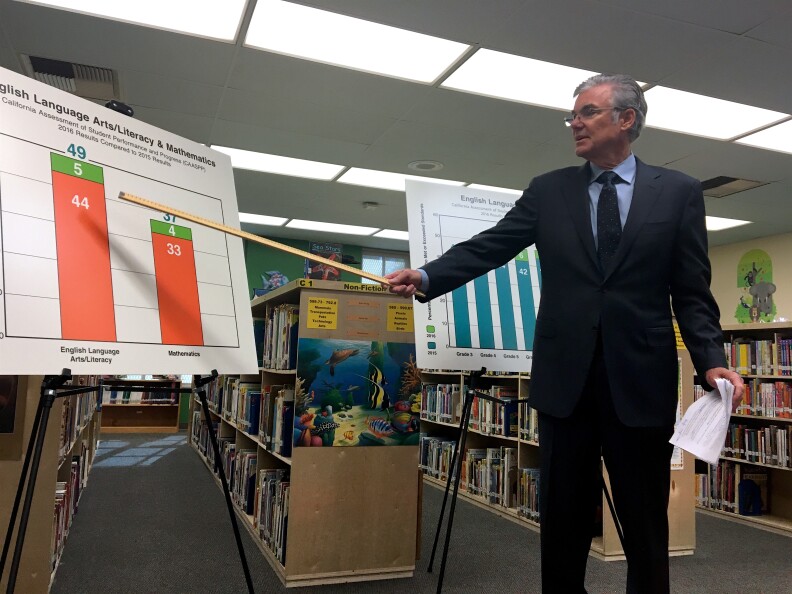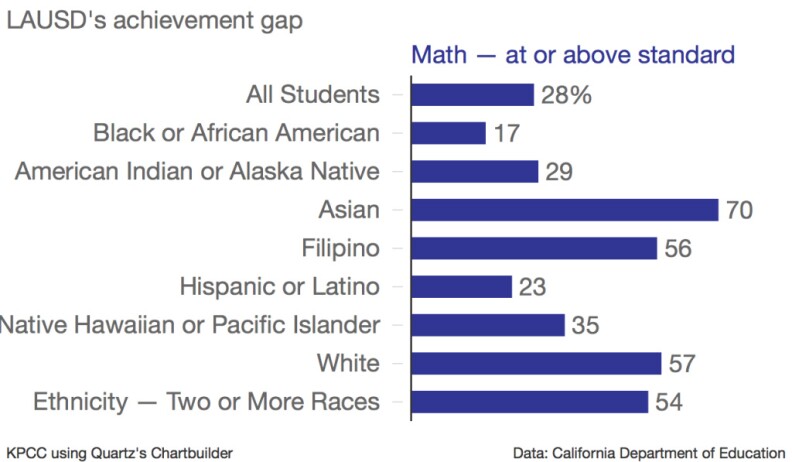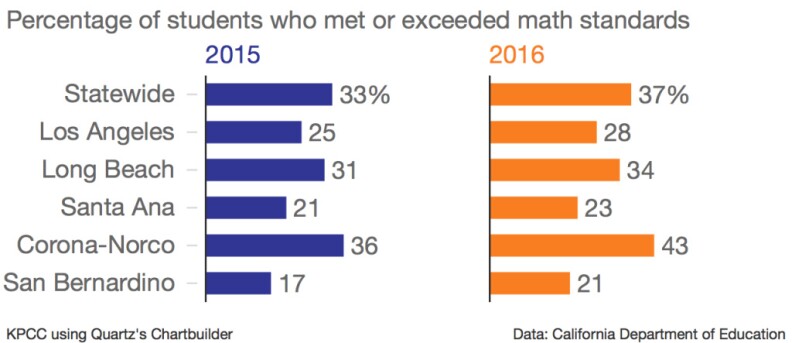This archival content was originally written for and published on KPCC.org. Keep in mind that links and images may no longer work — and references may be outdated.
California students post progress across the board on state tests, but struggles remain
More California public school students met state standards in English and math in 2016 than they did the year before, according to standardized testing results released Wednesday.
The percentage of the state's students who met or exceeded standards in English jumped five percentage points from last year, and the share of students who reached that goal in math climbed by four points.
“The higher test scores show that the dedication, hard work, and patience of California’s teachers, parents, school employees and administrators are paying off," said State Superintendent of Public Instruction Tom Torlakson in a written statement.
Torlakson attributed the gains to increased familiarity both with the new, online exams and with the state academic standards the tests are based on.
But even with the gains, just over half of students still failed to clear the state's bar on the English tests. More than 60 percent nearly met or did not meet math standards. And big achievement gaps persist: white and Asian students still far meet standards at a much higher rate than their black and Hispanic peers, and low-income students and English learners are still far behind more affluent and native English speaking students.
"We totally understand that those levels of 'met or exceeded standards' are way, way too low," Torlakson said after a press conference at Los Angeles' Eagle Rock High School on Wednesday. "But we're seeing that California, in these test results, other states that have used the same testing system— we're right there, right in the middle, and we want to go to the very top."

The results indicate that schools are making progress, but many students are still struggling to reach California's challenging, relatively new benchmarks for measuring college and career readiness.
It's the second year that the public has seen results from the new exam, known alternately as the California Assessment of Student Performance and Progress (CAASPP) or the Smarter Balanced Assessment. Last year, education officials cautioned not to draw conclusions from students' performance because the new exams are significantly more challenging than previous standardized tests.
But this year's data provides the first opportunity to see an individual student or school's progress.
"It is so much better than the old system," Torlakson said. "It is based on new more rigorous standards that are more relevant. It's a new way of thinking — a new way of instructing and a new way of learning."
Despite progress, achievement gaps persist
Troubling gaps persist between the performance of black and Hispanic students and their white and Asian counterparts. While all demographic groups posted progress statewide, the gulf between the percentage of white and black students meeting standards remains unchanged. The distance between white and Hispanic students' performance narrowed by just one percentage point.
"Persistent and pernicious" achievement gaps also remain between low-income students and their peers, Torlakson noted in his statement.
He also highlighted the gap between students who are still learning English and their peers; though one out of every five California students is an English learner, this subgroup met or exceeded standards on both math and English exams at some of the lowest rates.
"We must find the best strategies to help our English learners succeed in reclassification — in getting off the English learner lists and being proficient," Torlakson said during his press conference.


In English, a greater share of students statewide are meeting or exceeding standards in high school. In math, younger students are passing the bar at higher rates.


The California State University system and many of the state's community colleges consider students ready for their workload if they meet or exceed the test's standards as 11th graders.
By that standard, significantly more students are ready for college ready work in English than they are in math. Nearly 60 percent of 11th graders met or exceeded goals on the literacy tests, but only a third passed the bar in math.
But statewide, younger students performed much better on the math exams. While 46 percent of 3rd grade students met or exceeded standards, but the percentage of students reaching those goals decreased in the older grades. Torlakson said he has instructed his staff to explore this trend.
"It could be that mathematics, you learn in sequences," Torlakson said. "So we have a couple of years to get into the right sequences in math. But we don’t have a definitive answer."
Because students complete the exams online, teachers get results more quickly.
"That’s very valuable," said Stephanie Leach, the principal of Eagle Rock Elementary School. "It used to be very frustrating for us to test in May, for example, and not get our results for into the new year, and teachers were already focusing on their new students."
Leach said the data teachers receive from California's new tests might not yet be broken down into details "at the level we were once accustomed to." She said students are still getting familiar with the online testing platform.
However, during the 2015-16 testing period, "the kids were significantly more comfortable with the platform than they were the year prior," Leach said. "We were having less connectivity issues, things weren’t going offline."
Students in Southern California's largest school districts also posted progress, but generally performed less well compared to statewide averages.


Among Southern California districts, Long Beach Unified School District most closely mirrored the performance of students statewide.
Student performance in Los Angeles Unified School District, the state's largest, lags behind the state at large.
However, the district posted some of the largest gains among the state's urban districts. In English, for example, LAUSD – along with Pasadena, San Bernardino and San Diego – posted six percentage point gains on the exams. In math, the percentage of LAUSD students who met or exceeded standards climbed four points.
"Once again, our district and our students have risen to the occasion," said L.A. superintendent Michelle King at a press conference.
"Even as we celebrate our progress today," she added later, "we must recommit ourselves to the achievement of all students. We must continue striving to close the achievement gap and to provide the resources needed to help our disadvantaged students succeed."
Pomona, San Diego and Fresno's districts posted similar gains.
This post was updated at 12:15 p.m. to include additional reactions from Torlakson, Leach and King.









